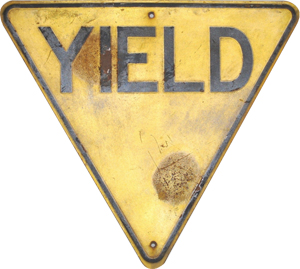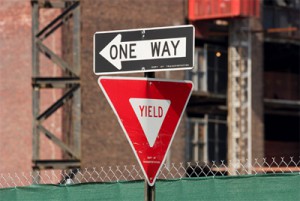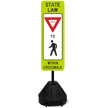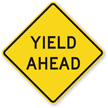A history of the silent nag: the yield sign
Motorists slow down and look around cautiously when they see a yield sign. But they don’t wonder how that sign got there in the first place. The yield sign, an unsung hero, has actually been saving lives since 1950, when the first sign was placed at the corner of First Street and Columbia Avenue in Tulsa, Oklahoma.
Before the sign was introduced, the intersection was one of the most dangerous in the area; it was difficult to enforce the right of way law that was already in place. Officer Clinton Riggs, a Tulsa native, developed a sign that he hoped would alleviate these problems. He also wanted to make the liability clear in the event of a collision.
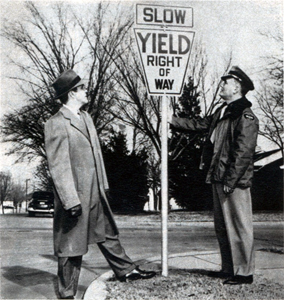
This picture from 1952 shows the original yield sign developed by Clinton Rigg and posted in Tulsa, OK.
The ‘Eve’ yield sign was keystone shaped and had “Yield Right of Way” written in black letters against a bright yellow background; reflective material wasn’t available and yellow was the most visible at night. Within a year of the sign’s posting, accident rates dropped dramatically; drivers learned to approach the intersection with caution. Inspired by the success of the original sign, Tulsa posted more yield signs and spread the word to neighboring cities.
The Manual on Uniform Traffic Control Devices (MUTCD) added the yield sign in 1954 to assign right of way at intersections where a stop was not normally required. However, rather than a keystone, the yield sign was now a yellow, upside-down equilateral triangle (more eye-catching) with “yield” in black lettering and border. Yield signs are unique in their family; they’re the only signs that are shaped like a triangle. They were officially initiated in September 1956, when Florida’s St. Petersburg Times printed an article detailing the use of a yield sign and commenting on its shape.
The MUTCD mandated: yield signs are used to assign right of way and instruct drivers when they must stop and slow down. They should be posted in an unobstructed place where sight lines make it difficult to see oncoming traffic.
In 1971, the MUTCD stipulated that yield signs should be red with a white triangle in the center and red lettering, as red is more eye-catching, and the invention of reflective film made different colors possible. These signs have grown in popularity all around the world and are used more often than stop signs in many European countries.
Yield signs have proven to be an invaluable addition to road safety; intersections are safer, and the liability is clear if a collision does occur. Just as Clinton Riggs hoped.
Category: Road safety, Traffic law














